Break of gauge
With railways, a break of gauge occurs where a line of one gauge meets a line of a different gauge: specifically a different track gauge. Trains and rolling stock cannot run through without some form of conversion between gauges, and freight and passengers must otherwise be transshipped. A break of gauge adds delays, cost, and inconvenience.
| Track gauge | ||||||||||||||||||||||||||||||||||||||||||||||||||||||||||||||||||||||||||||||||||||||||
|---|---|---|---|---|---|---|---|---|---|---|---|---|---|---|---|---|---|---|---|---|---|---|---|---|---|---|---|---|---|---|---|---|---|---|---|---|---|---|---|---|---|---|---|---|---|---|---|---|---|---|---|---|---|---|---|---|---|---|---|---|---|---|---|---|---|---|---|---|---|---|---|---|---|---|---|---|---|---|---|---|---|---|---|---|---|---|---|---|
| By transport mode | ||||||||||||||||||||||||||||||||||||||||||||||||||||||||||||||||||||||||||||||||||||||||
|
Tram · Rapid transit Miniature · Scale model |
||||||||||||||||||||||||||||||||||||||||||||||||||||||||||||||||||||||||||||||||||||||||
| By size (list) | ||||||||||||||||||||||||||||||||||||||||||||||||||||||||||||||||||||||||||||||||||||||||
|
||||||||||||||||||||||||||||||||||||||||||||||||||||||||||||||||||||||||||||||||||||||||
| Change of gauge | ||||||||||||||||||||||||||||||||||||||||||||||||||||||||||||||||||||||||||||||||||||||||
|
Break-of-gauge · Dual gauge · Conversion (list) · Bogie exchange · Variable gauge |
||||||||||||||||||||||||||||||||||||||||||||||||||||||||||||||||||||||||||||||||||||||||
| By location | ||||||||||||||||||||||||||||||||||||||||||||||||||||||||||||||||||||||||||||||||||||||||
|
North America · South America · Europe · Australia 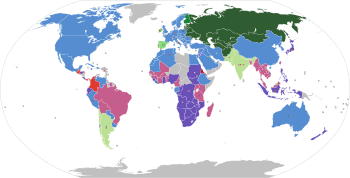 |
||||||||||||||||||||||||||||||||||||||||||||||||||||||||||||||||||||||||||||||||||||||||
Advantages and disadvantages
Advantages
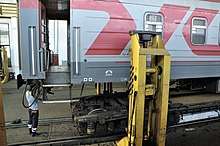
- Narrow-gauge railways often have smaller loading gauges and sharper curves, which tend to reduce initial capital costs. These railways were often economically marginal lines, perhaps through hilly and mountainous terrain, where it would not have been economic to build a full-size railway. Many of these rail lines were operated independently of potentially connecting lines, as competing companies built and operated them. Thus the cost of transfer between different gauges was often irrelevant. Only the building of union stations or the nationalization of railroads changed this.
- Invading armies may be severely hampered (as when Germany invaded the USSR in World War II). Spain (which had been invaded by Napoleon) deliberately maintained a wider gauge than France for this reason. This did not change until the beginning of the high-speed, standard-gauge AVE in 1992. The rest of the network continues to run on wide gauge.
- If the railways also have different loading gauges, the break of track gauge might help prevent the larger wagons straying onto lines with smaller tunnels.[1]
- Similarly, if the larger and smaller gauges use different couplers or brakes, the break of gauge tends to keep the different couplers separate.
For passengers
For passenger trains the inconvenience is less, especially at major stations where many passengers change trains or end their journeys anyway. Therefore, some passenger-only railways have been built with gauges not otherwise used in the country concerned. For example, the high-speed railways (and some rapid transit lines) in Japan and Spain use 1,435 mm (4 ft 8 1⁄2 in) while their respective mainline railroad systems use 1,067 mm (3 ft 6 in) and 1,668 mm (5 ft 5 21⁄32 in).
For night trains, which are very common in countries such as Russia, the requirement to change trains is more inconvenient. In this case, often the bogies are replaced, even if it takes much more time than having passengers change trains.
For towns along the lines
If local government has influence over the construction of railways, some may see it as desirable for trains (and passengers) to stop in rather than pass through their town. For instance, prior to the US Civil War, many cities in the South had a break of gauge or two separate stations at different ends of town, necessitating a change of trains or time-consuming transshipment, which nonetheless brought commerce and profit to the towns. Not until the Civil War did state and Confederate authorities notice the military and economic problems this brought, and only the post-bellum Union government was able to largely solve those problems, by converting almost all lines to standard gauge.
Disadvantages

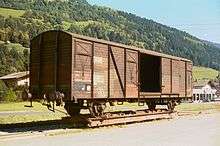
Transshipping freight from cars of one gauge to cars of another is very labour- and time-intensive, and increases the risk of damage to goods. If the capacity of the freight cars on both systems does not match, additional inefficiencies can arise. If the frequency is low, a train might need to wait a long time for its counterpart to arrive before transshipping. This might be avoided by storing the goods, but that is also costly and inconvenient.
Technical solutions to avoid transshipping include variable gauge axles, replacing the bogies of cars, and using transporter cars that can carry a car of a different gauge.
The Spanish manufacturers Talgo and CAF have developed dual-gauge axles (variable gauge axles) which permit through running between broad-gauge and standard-gauge lines. In Japan the Gauge Change Train, built on Talgo patents, runs on both standard and narrow 1,067 mm (3 ft 6 in) gauge.
Breaks-of-gauge might also be avoided by installing dual-gauge track, either permanently or as part of a project to replace one gauge with another.
At most breaks-of-gauge passengers have to change trains, but there are a few trains that run through, for example, the Talgo (variable-gauge axles, see above), and trains from Russia to China or Russia to Europe (bogie exchange), although on the latter two the passengers usually have to leave the train for some time whilst the accommodation work is done.
When buying trains
Railroads with unusual gauges or loading gauges have problems procuring trains, and may be forced to choose between an oligopoly or even a monopoly supplier that caters to their specific needs. This may be deliberate on the part of suppliers: some streetcar lines were built to unique specifications to ensure buyer lock-in. However, in modern times rail gauge itself is often not the most important factor, but rather other aspects like the electrification system or the loading gauge. Trains crossing the Channel Tunnel, for instance, had to be custom made before High Speed 1 was built, despite both Britain and France having standard gauge, because the British loading gauge is narrower and the legacy lines in the south of Britain were electrified through third rail rather than overhead wiring.
Overcoming a break of gauge
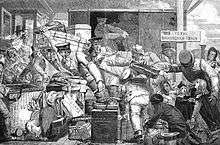
Where trains encounter a different gauge, such as at the Spanish–French border or the Russian–Chinese one, the traditional solution has been transloading (often called transshipment in discussions of break of gauge), that is, the transfer of passengers and freight to cars on the other system. When transloading from one gauge to another, often the quantities of rolling stock are unbalanced between the two systems, leading to more idle rolling stock on one system than the other. This is obviously far from optimal, and some other schemes have been devised.
Various solutions other than transloading were conceived even in the early era of railways in Britain[2]:202–203 (including rollbocks, transporter wagons, dual gauge, and even containerization or variable gauge axles), but they were not implemented during the nastiest flare-up of the Gauge War in the 1840s, which resulted in horrendous spectacles of confused and wasteful transloading.[2]:202–203 L. T. C. Rolt's biography of Isambard Kingdom Brunel (mastermind of the broad gauge) remarks on the apparent mysteriousness of this lack of implementation,[2]:202–203 but a likely explanation is that the combatants at the time were more interested in winning the Gauge War, defeating the other gauge, than in demonstrating how peaceful coexistence could be developed. Rolt states that the shocking confusion seen in an editorial cartoon of transloading chaos at Gloucester in 1843 was deliberately contrived, as later admitted by a railway goods manager, as a spectacle for a visiting parliamentary committee.[2]:202–203 Rolt states that the germ of the idea of containerization was known even at this time,[2]:202–203 which is interesting in that the full potential of containerization was not thoroughly developed until a century later, after World War II.
Lack of a standard gauge was a significant problem in transportation in the Confederate States of America during the American Civil War.
Bogie exchange and variable gauge
One common method to avoid transshipment is to build cars to the smaller of the two systems' loading gauges with bogies that are easily removed and replaced with other bogies at an interchange location on the border. This takes a few minutes per car, but is quicker than transshipment of goods.
A more modern and sophisticated method is to have multigauge bogies whose wheels can be moved inward and outward. Normally they are locked in place, but special equipment at the border unlocks the wheels and pushes them inward or outward to the new gauge, relocking the wheels when done. This can be done as the train moves slowly over special equipment.
Dual gauge and track gauge conversion
In some cases, breaks of gauge are avoided by installing dual-gauge track, either permanently or as part of a changeover process to a single gauge.
Piggyback operation
One method of achieving interoperability between rolling stock of different gauges is to piggyback stock of one gauge on special transporter wagons or even ordinary flat wagons fitted with rails. This enables rolling stock to reach workshops and other lines of the same gauge to which they are not otherwise connected. Piggyback operation by the trainload occurred as a temporary measure between Port Augusta and Marree during gauge conversion work in the 1950s to bypass steep gradients and washaways in the Flinders Ranges.[3][4]
Narrow-gauge railways were favoured in the underground slate quarries of North Wales, as tunnels could be smaller. The Padarn Railway operated transporter wagons on their 4 ft (1,219 mm) gauge railway, each carrying four 1 ft 10 3⁄4 in (578 mm) slate trams. When the Great Western Railway acquired one of the narrow-gauge lines in Blaenau Ffestiniog, it deployed a similar type of transporter wagon to allow continued use of the quarries' existing slate wagons.[5]
Transporter wagons are most commonly used to transport narrow-gauge stock along standard-gauge lines.
At the Guinness brewery in Dublin there used to be 1 ft 10 in (559 mm) internal narrow gauge and 5 ft 3 in (1,600 mm) gauge (standard gauge for Ireland), and to avoid the need for steam locomotives of both gauges the narrow-gauge engines were provided with standard-gauge converter wagons (named "haulage trucks"). The narrow-gauge steam locomotive was lowered into the haulage truck using a gantry, and its wheels rested on rollers, which in turn drove the haulage wagon wheels via a 3:1 reduction gear. Several of these locomotives survived into preservation, including locomotive No23 complete with haulage wagon and lifting gantry preserved at Brockham museum in 1966, and now at the Amberley Museum Railway.
More rarely, standard-gauge vehicles are carried over narrow-gauge tracks using adaptor vehicles; examples include the Rollbocke transporter wagon arrangements in Germany, Austria, and the Czech Republic, and the milk transporter wagons of the Leek and Manifold Valley Light Railway in England.
As of 2010, Japan is developing the Train on Train piggyback concept.
Containerisation
The widespread use of containers since the 1960s has made break of gauge less of a problem, since containers are efficiently transferred from one mode to another by suitable large cranes.
It helps if the lengths of the wagons on each gauge are the same so the containers can be transferred from one train to the other with no longitudinal movement along the trains. The different wagons should carry the same number of containers. Delays to each train depends on how many cranes can operate simultaneously.
Container cranes are relatively portable, so that if the break of gauge transshipment hub changes from time to time, the cranes can be moved around as required. Fork lift trucks can also be used.
It has been reported that, for example, when containers are shipped by a "direct train" from China to Europe, it is only containers, and not the railcars, which move from China's railway network to that of Kazakhstan. At the border station at Khorgos, two trains (the Chinese 1,435 mm or 4 ft 8 1⁄2 in standard gauge one and the Kazakh 1,520 mm or 4 ft 11 27⁄32 in one) would stand side by side at parallel tracks, while the cranes would move the containers from one train to the other in as short a time as 47 minutes.[6]
Types
Minor breaks of gauge
Wherever there are narrow-gauge lines that connect with a standard-gauge line, there is technically a break of gauge. If the amount of traffic transferred between lines is small, this might be a small inconvenience only. In Austria and Switzerland there are numerous breaks-of-gauge between standard-gauge main lines and narrow-gauge railways.
Many internal Swiss railways that operate in the more mountainous regions are 1,000 mm (3 ft 3 3⁄8 in) metre gauge, and most are equipped with rack assistance to deal with the relatively steep gradients encountered.[7] Through running of standard-gauge trains on rack sections would not be possible, but dual-gauge track exists in many places where the gradient is relatively flat to carry standard- and metre-gauge stock. There are also some 800-mm-gauge railways which are entirely rack operated.
The effects of a minor break of gauge can be minimized by placing it at the point where a cargo must be removed from cars anyway. An example of this is the East Broad Top Railroad in the US, which had a coal wash and preparation plant at its break of gauge in Mount Union, Pennsylvania. The coal was unloaded from narrow-gauge cars of the EBTR, and after processing was loaded into standard-gauge cars of the Pennsylvania Railroad.
Nominal breaks of gauge
The line between Finland and Russia has a nominal break of gauge; Finnish gauge is 1,524 mm (5 ft) whereas Russian gauge is 1,520 mm (4 ft 11 27⁄32 in). This does not usually prevent through-running, and in fact, such a service exists in the form of the Allegro high-speed service between Helsinki and St. Petersburg. The nominal 4 mm (0.16 in) difference is generally within tolerance, and the present Russian gauge is actually a redefinition of the older 1,524 mm (5 ft).
The Iberian gauge is actually three slightly different gauges: 1,672 mm (5 ft 5 13⁄16 in) in Spain, 1,664 mm (5 ft 5 1⁄2 in) in Portugal, and the newer, redefined 1,668 mm (5 ft 5 21⁄32 in). Through-running is done with vehicles having a gauge within certain tolerances. Indian gauge, 1,676 mm (5 ft 6 in), is also compatible with Iberian gauge, although there are no actual railway connections between the two. Despite this, old Spanish and Portuguese rolling stock have been reused in Argentina and Chile, both of which use Indian gauge.
A nominal break of gauge with standard gauge exists as well: on the Hong Kong MTR network, lines owned by MTR Corporation use 1,432 mm (4 ft 8 3⁄8 in) rather than the 1,435 mm (4 ft 8 1⁄2 in) employed on those owned by KCR Corporation, despite the lack of physical connections between the two networks.
Other types of breaks
A large railway may have main lines with heavy tracks, and branch lines with light track. Light locomotives and rolling stock can operate on all lines, but heavy locomotives and rolling stock can only operate on heavy track. Heavy rolling stock might be able to operate on lighter track at reduced speed. Light track can be upgraded to heavy track by installing heavy rails, etc., and this can be done without changing the track gauge.
Gauge conversions
Gauge orphan
When a main line is converted to a different gauge, branch lines can be cut off and made relatively useless, at least for freight trains, until they too are converted to the new gauge. These severed branches can be called gauge orphans.
Gauge outreach
The opposite of a gauge orphan is a line of one gauge which reaches into the territory composed mainly of another gauge. Examples include five broad-gauge lines from Victoria, Australia, which crossed the border into otherwise standard-gauge New South Wales. Similarly, the standard-gauge line from Albury to Melbourne in 1962 which eliminated most transshipment at Albury, especially the need for passengers to change trains in the middle of the night.
Two Russian broad-gauge lines reach out from Ukraine, one (the Uzhhorod–Košice line) into Slovakia to carry minerals; another (the Metallurgy Line) into Poland to carry heavy iron ore and steel products without the need for transshipment as would be the case if there were a break of gauge at the border. There are plans to extend the Slovak line to Vienna.[8]
In 1994, the Rail Baltica proposal emerged to build a 728 km north–south line to link European standard-gauge railways from Poland to Kaunas, Lithuania, and via Riga, Latvia, to Tallinn, Estonia.[9] In the shorter term (the 2010s) it will only be built to Kaunas.
The gauge outreach from Kalgoorlie to Perth partly replaced the original narrow-gauge line, and partly rebuilt that line with better curves and gradients as double-track dual gauge. Because of lack of space at the main Perth station, standard-gauge passenger trains terminate one station short at East Perth.
Other issues
While track gauge is the most important factor preventing through running between adjacent systems, other issues can also be a hindrance, including structure gauge, loading gauge, axleloads, couplings, brakes, electrification systems, signalling systems, multiple unit controls, rules and regulations, driver certification, righthand or lefthand running, repairs (how to make and pay for repairs while rolling stock is on other railway's territory) and language. The structure gauge, loading gauge and axleload problems are solved by simply using the smaller options for through running. The general solution is often to custom-build vehicles to fit all the standards to be encountered. Trains can be built to accept four voltages, to have dual signaling systems equipment, etc. All of these solutions, however, usually result in either more expensive trains or less comfort for passengers (e.g. through less room inside the train if it has a smaller loading gauge) or – in the case of freight railways – less room for cargo, making double stacking impossible or other negative effects.
Examples
Europe
United Kingdom
- Gloucester was the earliest significant break of gauge between the 1,435 mm (4 ft 8 1⁄2 in) and 7 ft 1⁄4 in (2,140 mm) systems.
- 1864 – Yeovil
Russian gauge meeting western gauge

- vs. Former Soviet Union countries: Russia, Lithuania, Belarus, Ukraine, Moldova (1,520 mm (4 ft 11 27⁄32 in)). Night trains are common, and they are often bogie-exchanged.
- Finland (1,524 mm (5 ft)) and Sweden (1,435 mm (4 ft 8 1⁄2 in)), between Tornio and Haparanda via a short dual gauge bridge. Freight is generally transloaded. No passenger trains. There is also a SeaRail train ferry (with 1,435 mm (4 ft 8 1⁄2 in) onboard) linking Turku, Finland with Stockholm, Sweden;[10] the Turku terminal handles both gauges.[11]
- Bulgaria (1,435 mm (4 ft 8 1⁄2 in)) railroad ferries to Ukraine, Russia and Georgia (1,520 mm (4 ft 11 27⁄32 in))
- Germany (1,435 mm (4 ft 8 1⁄2 in)) railroad ferries (from Sassnitz with 1,520 mm (4 ft 11 27⁄32 in) onboard) to Russia and Baltic States and to Finland (also from Travemünde with 1,435 mm (4 ft 8 1⁄2 in) onboard).
- Turkey and Iran vs Georgia, Armenia, Azerbaijan, Turkmenistan
- While breaks of gauge are generally located near borders, the Uzhhorod – Košice line carrying iron ore from Ukraine extends into Slovakian territory to a steelworks near Košice[12] and there are plans to extend the line further west, to Vienna.[8] See also Rail gauge in Slovakia.
- The historically first break of gauge between Russian and standard gauge was built in 1861 as dual gauge between the border stations of Eydtkuhnen, Germany (now Chernyshevskoye Kaliningrad Oblast, Russia), and Kybartai, then Russia, now Lithuania.
- The 1520 Strategic Partnership seeks to harmonise the gauges of Europe-Asia.[13]
Iberian gauge meeting western gauge
- France (1,435 mm or 4 ft 8 1⁄2 in) and Spain (1,668 mm or 5 ft 5 21⁄32 in), for example at Cerbère (FR) – Portbou (ES); Hendaye (FR) – Irun (ES) and Latour-de-Carol. From 2010 the Spanish high-speed network (1,435 mm or 4 ft 8 1⁄2 in) is connected to the French railways without a break of gauge.
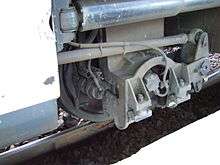
The earliest working example of the axle-changing system at the French-Spain border in 1948 had the axles being changed at the rate of 8 wagons or 32 axles per hour.[14]
Local narrow-gauge lines meeting mainlines
- Switzerland, see "Minor breaks of gauge" section below.
- The Harzer Schmalspurbahn took over a standard-gauge line from Deutsche Bahn when the latter had no more use for it and regauged it to meter gauge to prevent the problems of break of gauge. Nonetheless a break of gauge (and a change of train operator) still occurs at the point where that line connects to the rest of the DB network. DB itself has no break of gauge problems as the only non-standard-gauge railway it operates is on the island of Wangerooge without any train connection to the mainland.
North America
The United States of America had broad-, narrow-, and standard-gauge tracks in the 19th century, but is now almost entirely 1,435 mm (4 ft 8 1⁄2 in) standard gauge. Narrow-gauge operations are generally confined to isolated rail systems, with a few notable exceptions.




South America
- Argentina and Chile both use 1,676 mm (5 ft 6 in) broad-gauge tracks, but the link railway uses 1,000 mm (3 ft 3 3⁄8 in) narrow gauge with rack railway sections. There are two break-of-gauge stations, one at Los Andes, Chile, and the other at Mendoza, Argentina.
- A break of gauge between Argentina and Brazil, 1,435 mm (4 ft 8 1⁄2 in) to 1,000 mm (3 ft 3 3⁄8 in)
- A break of gauge between Uruguay and Brazil, 1,435 mm (4 ft 8 1⁄2 in) to 1,000 mm (3 ft 3 3⁄8 in) at Santana do Livramento.

Asia
China
China has a standard-gauge network; neighbouring countries Mongolia, Russia and Kazakhstan use 1,520 mm (4 ft 11 27⁄32 in) gauge, and Vietnam mostly uses 1,000 mm (3 ft 3 3⁄8 in) (metre gauge), so there are some breaks of gauge. See the Trans-Manchurian Railway (gauge changing at Zabaikalsk on the Russian side of the border), the Trans-Mongolian Railway and the Lanxin railway. The Yunnan–Vietnam Railway is narrow gauge, and is connected to standard-gauge tracks both in Kunming and in Hekou.[16] The Nanning-Hanoi line is dual gauge in Vietnam as far as Hanoi.[17] There is currently a break of gauge at Dostyk on the Kazakh border. Kazakhstan was planning to build an additional line using standard gauge,[18] between Dostyk and Aktogay but the scheme was abandoned.
Iran
Iran, with its standard-gauge rail system, has a break of gauge with 1,520 mm (4 ft 11 27⁄32 in) gauge at the borders with Azerbaijan and Turkmenistan, and also with Pakistan's 5 ft 6 in (1,676 mm) Indian gauge at Zahedan. The break-of-gauge station at Zahedan was built outside the city, as the existing station was hemmed in by built-up areas.[19]
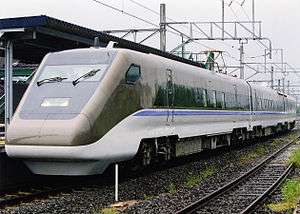
Japan
All high-speed "Shinkansen" routes in Japan have been built as standard-gauge lines. A few routes, known as "Super Tokkyū", have been planned as narrow-gauge 3 ft 6 in (1,067 mm), and the conventional (non-high-speed) is mostly narrow-gauge 3 ft 6 in (1,067 mm), so there are some breaks of gauge and dual gauge is used in some places. Private railways often use other gauges.
While most of the Japanese urban rail/metro lines use 1,067 mm (3 ft 6 in) rail gauge, a considerable number of lines (including all lines of the Osaka Metro) are still using their own different gauges including 762 mm (2 ft 6 in), 1,372 mm (4 ft 6 in), and 1,435 mm (4 ft 8 1⁄2 in).[20] This prevented the creation of some through train services.[21]
In 2010, Hokkaido Railway Company (JR Hokkaido) started working on a transporter train by trainload concept called "Train on Train" to carry narrow-gauge freight trains at faster speeds on standard-gauge flatcars. The Seikan Tunnel has beien converted by JR Hokkaido to dual gauge to accommodate the Hokkaido Shinkansen.
An experimental program for a variable gauge "Gauge Change Train" started in 1998 as a means to allow through services from high-speed standard-gauge Shinkansen lines to narrow-gauge regional lines. Its first deployment was expected to be the Kyushu Shinkansen Nagasaki route. However, the program was cancelled in 2008.[22]
North Korea
The North Korean rail system has some breaks of gauge. Several parts of the Paektusan Ch'ŏngnyŏn Line on the stretch between Wiyŏn and Hyesan Ch'ŏngnyŏn are dual gauged to allow connections to the Paektusan Rimch'ŏl Line and the Samjiyŏn Line.[23] Also, the line connecting to the Trans-Siberian Railway from Rajin to Khasan is dual gauged for standard gauge and Russian gauge.[24]
Sakhalin
In the 20th century, railroads on the entire Sakhalin used the same 3 ft 6 in (1,067 mm) narrow gauge as Japan, as part of it was under Japan's control when railway construction began. One stretch of rail that used 600 mm (1 ft 11 5⁄8 in) narrow gauge was converted to match the 3 ft 6 in (1,067 mm) narrow gauge after Russia took control of it.
Starting from the 1970s, a train ferry service was provided to connect Sakhalin and the Russia mainland, requiring bogie exchange on wagons to allow operation on the Russian mainland 1,520 mm (4 ft 11 27⁄32 in) broad gauge.
In 2003, the Russian government started to convert the entire network to dual gauge with 3 ft 6 in (1,067 mm) and 1,520 mm (4 ft 11 27⁄32 in). Work is 70% done as of 2016, and is expected to be complete by 2018. The entire island's rolling stock is expected to be replaced by 1,520 mm (4 ft 11 27⁄32 in) rolling stock by 2020, thus eliminating the break of gauge between Sakhalin and the Russian mainland.[25]
Taiwan
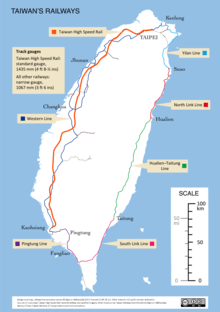
Like Japan, rail transport in Taiwan uses the 3 ft 6 in (1,067 mm) gauge for the majority of its railway network, but 1,435 mm (4 ft 8 1⁄2 in) standard gauge for its high-speed rail; however, gauge differences are less of a problem as Taiwan High Speed Rail generally uses separate rolling stock and its own separate railway, and at most locations runs on routes kilometres away from the conventional Taiwan Railways Administration railway network.
Africa
- Rail lines linked by ferries on convenient rivers or lakes. See train ferries.
- Dar es Salaam is one of the few places in Africa where different gauges actually meet.
- Kidatu in Tanzania has a container transshipment facility to move freight containers between TAZARA 1,067 mm (3 ft 6 in) and Tanzania Railways Corporation trains 1,000 mm (3 ft 3 3⁄8 in)
- D. R. Congo originally had both 1,000 mm (3 ft 3 3⁄8 in) and 3 ft 6 in (1,067 mm) lines, but when these lines met in the 1950s, the 1,000 mm (3 ft 3 3⁄8 in) line was converted to 3 ft 6 in (1,067 mm).
- In the rest of Africa, railways of different gauges in adjacent countries often do not actually meet, so there is no actual break of gauge.
Australia


_of_the_1945_Clapp_Report_proposals_for_standardisation_of_Australia's_railways.png)
Origins of Australia's multi-gauge muddle
In 1845, the South Australian newspaper mentioned the convening of a Royal Commission in Britain "inquiring whether, in future private acts of parliament for the construction of railways, provision ought to be made for securing an uniform gauge, and whether ... to bring the railways already constructed, or in progress ... into uniformity". It continued, "Since the colonists are now moving the question of railroads, we direct their special attention to the following. A uniform gauge will be of the utmost importance to the internal traffic of the province;[note 1] and the time to determine the proper and most convenient width of the rail, is at the commencement".[27]
The two mainland colonies at the time[note 2] then agreed to adopt the 4 ft 8 1⁄2 in (1,435 mm) gauge: South Australia in 1847[28][29] and New South Wales in 1848.[29]
However, in 1850 New South Wales decided to change to 5 ft 3 in (1,600 mm), or Irish gauge. The change was approved by the British government, and South Australia agreed to follow suit.[30] However, in 1853 New South Wales unilaterally reverted to the 4 ft 8 1⁄2 in (1,435 mm) gauge. South Australia and Victoria, the latter now separated from New South Wales, protested about the broken agreement, to no avail. Because they had already invested in broad-gauge track, locomotives and rolling stock, they continued construction.
There followed years of nationally uncoordinated railway construction designed not to serve the needs of the nation but the needs of the railways' parent colonies. They made their gauge choices in accordance with their perception of their own economic and geographical circumstances and to buttress, if not promote, their individual identities as colonies.[31]
It was to be 90 years before a national investigation of standardisation of gauges was undertaken, in 1945.[32] Progress after that was still very slow, largely confined to linking all mainland capital cities with standard-gauge lines – achieved only in 1982.[33]
The American writer, Mark Twain, in 1879 summed up his experience of changing trains at Albury on a journey to Melbourne:[26]
Now comes a singular thing: the oddest thing, the strangest thing, the most baffling and unaccountable marvel that Australasia can show. At the frontier between New South Wales and Victoria our multitude of passengers were routed out of their snug beds by lantern-light in the morning in the biting-cold of a high altitude to change cars on a road that has no break in it from Sydney to Melbourne! Think of the paralysis of intellect that gave that idea birth; imagine the boulder it emerged from on some petrified legislator's shoulders.
The greatest number of break-of-gauge stations was in South Australia. There, 5 ft 3 in (1,600 mm) and 3 ft 6 in (1,067 mm) lines met, both at the time of their introduction and – at different places – of their gradual transition to standardisation, first to broad gauge and then to standard gauge. At various times these stations were: [34]
- Hamley Bridge
- Terowie
- Peterborough
- Gladstone
- three stations at various times at Port Pirie
- Port Augusta
- Marree
- Wolseley
- Mount Gambier.
Snapshot of Australian gauges, 2020
In broad terms,[note 3] Australia's railway gauges were as follows in 2020:
- Queensland: 1,067 mm (3 ft 6 in), except for a standard gauge line from Brisbane to the New South Wales border; also several thousand kilometres of 610 mm (2 feet) lightweight trackage for transport of sugar cane
- New South Wales: entirely 1,435 mm (4 ft 8 1⁄2 in)
- Victoria: 1,600 mm (5 ft 3 in), except for a standard gauge line from Melbourne to the New South Wales border
- South Australia: 1,600 mm (5 ft 3 in) in the Adelaide suburban area; standard gauge lines to Western Australia, Victoria, New South Wales and the Northern Territory; one 1,067 mm (3 ft 6 in) line carrying gypsum in the far west and others carrying iron ore to Whyalla
- Western Australia: 1,067 mm (3 ft 6 in), except for a standard gauge line from Perth to the South Australian border and, branching from it at Kalgoorlie, lines south to Esperance and north to Leonora; heavy rail lines in the north (Pilbara) transporting iron ore to port
- Tasmania: 1,067 mm (3 ft 6 in).
New Zealand
New Zealand originally had small lengths of lines of 3 ft 6 in (1,067 mm), 4 ft 8 1⁄2 in (1,435 mm) and 5 ft 3 in (1,600 mm), but quickly converted all to 3 ft 6 in (1,067 mm), which better suited the sparsely, populated and mountainous country.
Notes
- That is, South Australia.
- Victoria had not yet become a separate colony from New South Wales; the colonies would not federate into one nation until 1901.
- Ignoring preserved railways and tramways, the most notable being Victoria's Puffing Billy Railway (762 mm (2 ft 6 in)) and South Australia's Pichi Richi Railway (1,067 mm (3 ft 6 in)) and SteamRanger (1,600 mm (5 ft 3 in)).
References
- "Tramway League". South Bourke and Mornington Journal. Richmond, Vic.: National Library of Australia. February 4, 1885. p. 3 Edition: Weekly. Retrieved December 5, 2011.
- Rolt 1989.
- "Piggyback picture".
- "Flinders Ranges Research".
- Gray, Adrian (Winter 1994). "G. W. R. Slate Tram Transporter Wagons". British Railway Journal (50): 17–24.
- Shepard, Wade (January 28, 2016), "Why The China-Europe 'Silk Road' Rail Network Is Growing Fast", Forbes
- "enlarged map". Retrieved February 19, 2011.
- "Railway Gazette: Broad gauge to Wien is feasible, says study". Retrieved December 21, 2010.
- Railway Gazette International July 2011, p 25.
- SeaRail ferry Archived December 26, 2009, at the Wayback Machine. Retrieved 2010-03-18
- "SeaRail Turku dual-gauge terminal". Archived from the original on July 24, 2011. Retrieved March 18, 2010.
- "Railways in Slovakia".
- Railway Gazette International Oct 2011 p48
- "Break of gauge device pleases". The Barrier Miner. Broken Hill, NSW: National Library of Australia. July 16, 1951. p. 5. Retrieved November 3, 2011.
- Gary Richards, Gary Richards (April 4, 2014). "Roadshow: eBART trains along Highway 4 could be running in 2017". Contra Costa Times. MNG Corporate. Retrieved February 24, 2015.
- Lu, Hua (陆华); Guo, Weina (郭薇娜) (April 24, 2015), 昆明铁路局:国际铁路联运开启云南货运新篇章 (Kunming Railway Bureau: An international railway link opens a new chapter in Yunnan's freigh transportation)
- The length of Vietnam railway network Archived April 18, 2010, at the Wayback Machine
- "Trans-Kazakhstan link will complete standard-gauge transcontinental artery". Railway Gazette. August 1, 2004. Retrieved April 28, 2011.
- Stubbs, John (January 1, 2007). "Closing the gap from Bam to Zahedan". Railway Gazette International. Retrieved May 26, 2011.
- http://www.jterc.or.jp/topics/josei_shinpo3.14/5_chokutu_unten.pdf
- "川崎市:ページが見つかりません". sc.city.kawasaki.jp.
- "新幹線のFGT導入を断念" (in jp). August 24, 2008. Retrieved June 21, 2020.CS1 maint: unrecognized language (link)
- http://www.cybernk.net/infoText/InfoHumanCultureDetail.aspx?mc=CC0501&sc=A33005001&tid=CC040100007874&direct=1&direct=1
- "라진-하산(러시아) 철도, 10월 중순 첫 시험운행". news.naver.com.
- "Новости - Дальневосточный федеральный округ - interfax-russia.ru". www.interfax-russia.ru.
- Twain, Mark (2020). "Following the Equator". The Literature Network. Retrieved May 27, 2020.
- "The proposed railroad". The South Australian. VIII (686). (Original, Adelaide. Digital reproduction, Canberra: National Library of Australia – Trove digital newspaper archive. December 12, 1845. p. 3. Retrieved May 27, 2020.
- "Proceedings of the Legislative Council". The South Australian. Adelaide: National Library of Australia. October 8, 1847. p. 3. Retrieved November 26, 2011.
- "Local Intelligence". Bell's Life in Sydney and Sporting Reviewer. National Library of Australia. December 1, 1849. p. 2. Retrieved November 27, 2011.
- "Railway Papers". South Australian Register. Adelaide: National Library of Australia. August 28, 1851. p. 3. Retrieved November 27, 2011.
- Mills, John A. (June 1, 2010). "Australia's mixed gauge railway system: a reassessment of its origins". Griffith University. Retrieved May 27, 2020.
- Report into the Standardisation of Australia’s Rail Gauges, Sir Harold Clapp, 1945. National Archives of Australia: series A5954, item 717/2
- Vincent, Graham (2013). "South Australia's mixed gauge muddle" (PDF). National Railway Museum [South Australia]. National Railway Museum. Retrieved August 14, 2019.
- "National rail map". Australian rail maps. Australian rail maps. 2020. Retrieved May 28, 2020.
Bibliography
- Rolt, L. T. C. (1989) [1957]. Isambard Kingdom Brunel. Prentice Hall Press. ISBN 978-0-582-10744-1.CS1 maint: ref=harv (link)
See also
- Erie Gauge War
- Eurasian Land Bridge
- Gauntlet track
- Janes World Railways has maps that generally show breaks-of-gauge.
- Piggyback (transportation)[1][2]
- Ramsey car-transfer apparatus
- Track gauge conversion
- Variable gauge axles
- INTERGAUGE a form of VGA
- SUW 2000 a form of VGA
External links
- Jane's World Railways (hard copy)
- Transport and Telecommunication:The operation of the gauge changing facility of the new railway line Rail Baltica, Jonas Jonaitis, Vol.7, No 1, 2006
